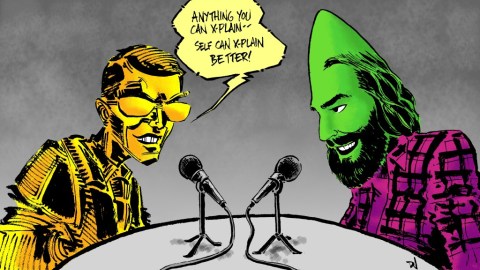Listen to the episode here!

Because It's About Time Someone Did
Listen to the episode here!

Podcast: Play in new window | Download
Subscribe: Apple Podcasts | Spotify | Android | RSS

In which the New Mutants learn that they are not, in fact, immortal; Louise Simonson finds her stride; the Ani-Mator makes Cameron Hodge look downright reasonable; hating humans is Magneto’s security blanket; Doug Ramsey dies; and we continue our coverage of the Fall of the Mutants.
X-PLAINED:
NEXT WEEK: …Just Before Dawn
You can find a visual companion to this episode on our blog!
Find us on iTunes or Stitcher!
Rachel and Miles X-Plain the X-Men is 100% ad-free and listener supported. If you want to help support the podcast–and unlock more cool stuff–you can do that right here!
Buy prints of this week’s illustration at our shop, or contact David Wynne for the original!
Podcast: Play in new window | Download
Subscribe: Apple Podcasts | Spotify | Android | RSS

In which Louise Simonson’s New Mutants run gets off to a rough start; drugs are not a reliable way to impress your space girlfriend; Magma gets a character arc; Tarot’s powers are kind of iffy; it’ll take more than a few illegal fish to stop Magik; and Bird Brain thoroughly fails to live up to his potential.
X-PLAINED:
NEXT WEEK: Live in Las Vegas!
You can find a visual companion to this episode on our blog!
Find us on iTunes or Stitcher!
Rachel and Miles X-Plain the X-Men is 100% ad-free and listener supported. If you want to help support the podcast–and unlock more cool stuff–you can do that right here!
We’ll have prints of this week’s illustration up at our shop later this week. As always, you can contact David Wynne to inquire after the original!
Listen to the episode here.




LINKS:
Podcast: Play in new window | Download
Subscribe: Apple Podcasts | Spotify | Android | RSS

In which we go back in time to take a look at two annuals; everyone is really excited about Excalibur; Claremont ups his illusion game; Horde should probably not be allowed to dress himself; Rachel fires the X-Men; Havok needs better role models; Psylocke’s secondary mutation is femme power; Kyle X-Plains giant monsters; we check in with Super Doctor Astronaut Peter Corbeau; and you should totally come see us at Vegas Valley Comic-Book Festival on November 7!
X-PLAINED:
NEXT EPISODE: All-New X-Men with Dennis Hopeless!
You can find a visual companion to this episode on our blog!
Find us on iTunes or Stitcher!
Rachel and Miles X-Plain the X-Men is 100% ad-free and listener supported. If you want to help support the podcast–and unlock more cool stuff–you can do that right here!
Buy prints of this week’s illustration at our shop, or contact David Wynne for the original!
Listen to the episode here!

LINKS:
Podcast: Play in new window | Download
Subscribe: Apple Podcasts | Spotify | Android | RSS

In which the New Mutants return from space; Professor Xavier ruins everything; Magneto is the Craig Pelton of X-Men; Cypher carouses shamefully with Hellfire tramps; Karma quits the team; and we wrap up Chris Claremont’s New Mutants run.
X-PLAINED:
NEXT WEEK: It’s hard to be Havok.
You can find a visual companion to this episode on our blog!
Find us on iTunes or Stitcher!
Rachel and Miles X-Plain the X-Men is 100% ad-free and listener supported. If you want to help support the podcast–and unlock more cool stuff–you can do that right here!
Buy prints of this week’s illustration at our shop, or contact David Wynne for the original!
Listen to the episode here.

LINKS:
Listen to the episode here.

If you want to follow along with the crossover, you can find a guide to the reading order–and how we’re dividing it between episodes–here.